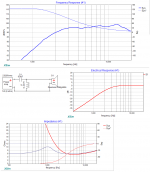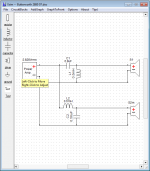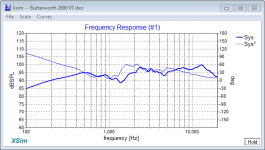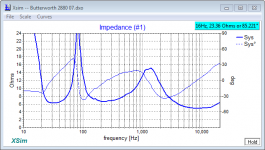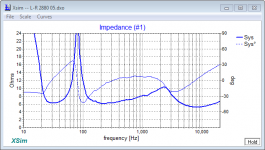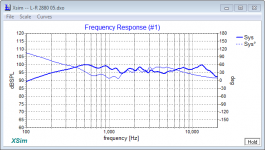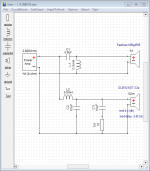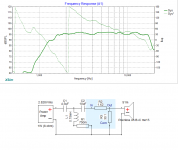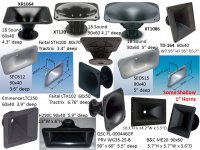Well, ( as a final ) that's more of a starting point .
One needs to be working with real frequency response files and real impedance files to design a working crossover.
One can get close using the manufacturers published response curves ( if they exist ) by using tracing software that then saves the curve/trace as either a .frd ( frequency response ) or .zma ( impedance ) file.
Here's a closer ( to reality ) effort using traced info ( simmed within XSim ) to give you something a bit safer for the tweeter.
For the woofers lowpass circuit I'd suggest empirically playing with coils/inductors size ( realizing that when placed in series you can directly add the values together to get one of larger value ).
A larger size will preserve the low-end while burning away the midrange ( effectively reducing or eliminating the need for any resistors.
The parallel cap ( in the woofers low-pass ) can be sized accordingly to get the amount of mids needed ( by ear ) in the crossover region.
- Remember, one can add the values of caps directly together when they are paralleled, to achieve a larger value.
- Therefore, choosing a Xover by ear can be facilitated by having on hand, caps of various values that you add ( or subtract ) capacitance.
Attachments
Last edited:
Hi EarlK, Thanks a lot - it's really a lot of help. I am feeding data into the the XSim. I note you are asking round for .frd & .zma files on my behalf for the ATC PA 75 STD from another poster. It will really help if something turns up - before I make a stab at getting into tracing something myself.
Hi,
Here's an XSim file ( zipped ) for you to play around with.
NOTE: It's a complete piece of fabricated fiction.
- It doesn't use actual measurements ( & worse, the woofer file is for a completely different midbass, ie; the Eminence DL2512 ).
OTOH, the benefit of playing around with this file is that it will give you an idea of what happens ( at crossover ) when one flips the polarity of a driver ( or adjusts the depth/offset between the voice-coils ) or adds & subtracts various LCR components.
ie; Getting the crossover area "right" is far from a trivial exercise ( it's usually more an exercise in frustration ).

Here's an XSim file ( zipped ) for you to play around with.
NOTE: It's a complete piece of fabricated fiction.
- It doesn't use actual measurements ( & worse, the woofer file is for a completely different midbass, ie; the Eminence DL2512 ).
OTOH, the benefit of playing around with this file is that it will give you an idea of what happens ( at crossover ) when one flips the polarity of a driver ( or adjusts the depth/offset between the voice-coils ) or adds & subtracts various LCR components.
ie; Getting the crossover area "right" is far from a trivial exercise ( it's usually more an exercise in frustration ).
Attachments
Great - I was on a similar trail. I had used some Dayton 270 RS files as a try out for the woofer in XSIM. Of course not the same as the target driver but just to get familiar with the tool. And I'm only at the point of looking at basic 2nd order LC low/high pass filters so far.
After a lot of tuning it comes out like this. I have used start values as Butterworth on HPF and Linkwitz-Riley on LPF with Fc at 2880 Hz. It is remarkably similar to the ATC SCM20SL I started to copy.
Next to try with the real ATC 75 3414CSTD woofer.
Next to try with the real ATC 75 3414CSTD woofer.
Attachments
Hi,
I'll need to think about that question ( but yes, there are some ).
I'll respond this evening ( my time ) after I'm back from work.
There are better tweeters ( that are also hi sensitivity ).
They are also more money ( for sure the current Peerless choice is the best value IMHO , given the criteria ).
So it really comes down to do you see this exercise as a long term investment in quality ( or more one of immediate need filling ) .

I'll need to think about that question ( but yes, there are some ).
I'll respond this evening ( my time ) after I'm back from work.
There are better tweeters ( that are also hi sensitivity ).
They are also more money ( for sure the current Peerless choice is the best value IMHO , given the criteria ).
So it really comes down to do you see this exercise as a long term investment in quality ( or more one of immediate need filling ) .
By the way - what do you think about the impedance spike at around 75Hz. Is that a normal charateristic of a mid range woofer that the amplifier has to adapt to?
Ported boxes will show two peaks in the impedance trace ( a sealed box will display a single impedance peak ).
The bottom of the trough ( created between the two peaks ) represents the boxes reflex tuning.
Modern amps are( generally ) not bothered by these impedance spikes ( ie; they don't usually need special impedance flattening circuits applied ).
Last edited:
Hi,
95db + HiFi tweeters are rare ( & invariably expensive when found ) .
It's a search that ultimately leads one back to what I've already recommended ( assuming budget is an issue ).
Since I'm in the SR ( sound reinforcement ) business I just about always turn to compression drivers when efficiency is needed ( since the global market has exploded with good > to great, small diaphragm compression drivers ) .
So, ( since you mentioned that Peerless Tymphany is now available to you ) take a look at the Peerless compression driver # DFM-2535r00-08-1
Its a great little compression driver ( very linear roll-off ) with good sound and easy to design a workable crossover for.
Here's an Xsim of a network ( using an original capture of this driver on a small waveguide made by B+C ) :
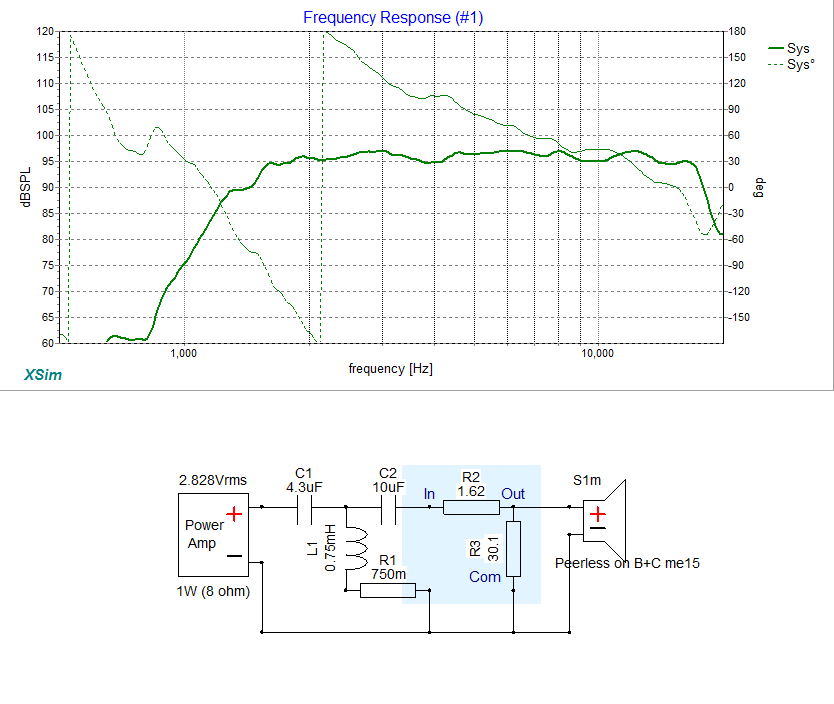

95db + HiFi tweeters are rare ( & invariably expensive when found ) .
It's a search that ultimately leads one back to what I've already recommended ( assuming budget is an issue ).
Since I'm in the SR ( sound reinforcement ) business I just about always turn to compression drivers when efficiency is needed ( since the global market has exploded with good > to great, small diaphragm compression drivers ) .
So, ( since you mentioned that Peerless Tymphany is now available to you ) take a look at the Peerless compression driver # DFM-2535r00-08-1
Its a great little compression driver ( very linear roll-off ) with good sound and easy to design a workable crossover for.
Here's an Xsim of a network ( using an original capture of this driver on a small waveguide made by B+C ) :
Attachments
In the crossover schematic there is much DC resistance.
Especially the 3R3 resistor will kill the damping factor of the amplifier.
This is something to consider when tuning a BR enclosure.
As it looks now you will have muddy, uncontrolled bass; everything a BR will do when not tuned properly.
Attenuating a woofer is very uncommon; normally tweeters are attenuated as they are often more efficient than woofers.
Especially the 3R3 resistor will kill the damping factor of the amplifier.
This is something to consider when tuning a BR enclosure.
As it looks now you will have muddy, uncontrolled bass; everything a BR will do when not tuned properly.
Attenuating a woofer is very uncommon; normally tweeters are attenuated as they are often more efficient than woofers.
In the crossover schematic there is much DC resistance.
Especially the 3R3 resistor will kill the damping factor of the amplifier.
This is something to consider when tuning a BR enclosure.
As it looks now you will have muddy, uncontrolled bass; everything a BR will do when not tuned properly.
Attenuating a woofer is very uncommon; normally tweeters are attenuated as they are often more efficient than woofers.
I suppose you ( Pieter) are referring to the following pic regarding your concerns.
I believe that "asteksonus" is no longer considering implementing the ideas represented in that schematic.
OTOH, as a learning experience, he may want to put a simple 1R - 3R ( ohms ) resistor inline with a woofer and then listen for it's effects ( it's entirely possible that with such a hi-sensitivity PA driver / ie; low Qes / bass response might actually improve ).
EarlK recommendation for a compression driver + horn can get you the best integration and directivity control. The large EconoWave diy-effort produced many similar 12" + waveguide designs which you can study. Waveguides like the SEOS-12 and SEOS-15 are "shallow horns" which often match the physical offset of the 12" voice coil for good time alignment.
The Peerless DFM-2535R00-08 1.4" dome will favor a slightly higher crossover frequency than the slightly more expensive Peerless DFM-2544R00-08 with a larger 1.75" dome. The DFM-2544R00-08 1.75" dome will support 1-1.2kHz crossovers often selected with 12" midbass. EarlK's crossover for the DFM-2535R00-08 looks like a good modest cost solution you should study.
The Peerless DFM-2535R00-08 1.4" dome will favor a slightly higher crossover frequency than the slightly more expensive Peerless DFM-2544R00-08 with a larger 1.75" dome. The DFM-2544R00-08 1.75" dome will support 1-1.2kHz crossovers often selected with 12" midbass. EarlK's crossover for the DFM-2535R00-08 looks like a good modest cost solution you should study.
Attachments
- Status
- This old topic is closed. If you want to reopen this topic, contact a moderator using the "Report Post" button.
- Home
- Loudspeakers
- Multi-Way
- Passive 2-way crossover for ATC PA 75
